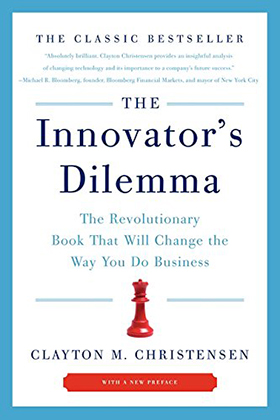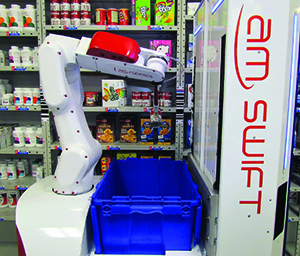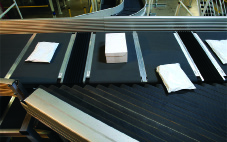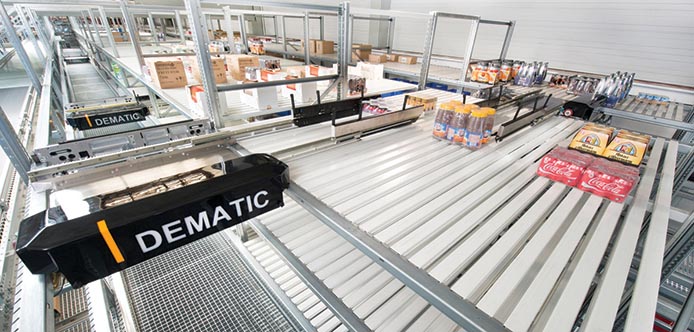Materials Handling Innovation (and why it matters)
Every company considers itself an innovator. It’s time to include materials handling leaders in that category.
Judging by the number of times the word innovation appears in a television commercial, you’d think that every company, in every industry, fancies itself an innovator. From technology to finance, companies are launching new features on cell phones, automobiles, beverages and even mortgages, all under the innovation umbrella.
Despite their diversity, the companies and their products share one thing in common: They all want to capture the same magic as Apple when it went from a computer hardware company with an uncertain future to one of the most highly valued companies on the planet by revolutionizing the way we talk to our friends, shoot video, listen to music and watch movies, all while disrupting traditional business models.
If you attended ProMat 2017, you may agree that it’s time to look at materials handling leaders as innovators. On the show floor, companies were demonstrating training and picking solutions using virtual and augmented reality; vision-based maintenance; mobile and piece-picking robotics; pocket sorters; and new software solutions. Are they all ready for prime time? Of course not. Many of these innovative solutions are still in search of a customer willing to do a pilot. But, they demonstrate the leaps the industry is taking after years of tweaking existing hardware.
As Markus Schmidt, president of Swisslog WDS Americas, puts it, “Innovation is on the agenda of every company in our industry because we all look for the next great thing that will change the market to our advantage.” Schmidt notes that innovation really came to the fore with the introduction of Kiva’s mobile robotics, followed by the shuttle—which shrunk the market for the mini-load by half overnight, and now competes with products like AutoStore. “Now a shuttle is old technology, so we’re all wondering what is the next great disruptive innovation,” he says. The emphasis is evident in the innovation awards MHI gives out at Modex and ProMat (2017 Innovation Award Winners).
Just what is innovation?
 That our industry is focusing on innovation comes as no surprise to James B. Rice Jr., deputy director of the Center for Transportation & Logistics at MIT. While Rice is not an expert in materials handling per se, he and his colleagues have been researching supply chain innovation for the past several years, including a column on the subject in Supply Chain Management Review. The starting point for their studies was the research by Clayton M. Christensen, a Harvard Business School professor and author of The Innovator’s Dilemma, one of the best-known books on the subject.
That our industry is focusing on innovation comes as no surprise to James B. Rice Jr., deputy director of the Center for Transportation & Logistics at MIT. While Rice is not an expert in materials handling per se, he and his colleagues have been researching supply chain innovation for the past several years, including a column on the subject in Supply Chain Management Review. The starting point for their studies was the research by Clayton M. Christensen, a Harvard Business School professor and author of The Innovator’s Dilemma, one of the best-known books on the subject.
Christensen distinguished between two kinds of innovation: sustaining and disruptive. As described by Rice, “sustaining innovations make products better through, say, lower prices or added features…disruptive innovations change the product offering by redefining the value proposition.” New features on a car, like a rear back-up camera before the competition, are sustaining; a self-driving car is disruptive.
While everyone wants to create the next disruptive product that redefines the market, Rice contends that most supply chain innovations—and we suspect most materials handling innovations—aren’t truly revolutionary. Rather, they’re “a clever combination of some existing technologies that have been applied in such a way that it has an impact on how things get done.” What’s more, the innovation is brought to scale.
A second premise is that innovation challenges what academics refer to as “the dominant design,” or the way things have always been done. Think of how the iPad changed the way consumers thought of a computer—then the dominant design. The best example in the materials handling world, says Rice, may have been the introduction of Kiva. Kiva introduced its mobile robots at ProMat in 2007 and Amazon.com Inc. acquired the company in 2012 for $775 million.
Before, the dominant design for goods-to-person picking involved a carousel or mini-load delivering a tote by conveyor to a workstation; at the workstation, pickers were directed by voice, lights or a screen. “Kiva turned the dominant design on its head,” Rice says. Still, it did so through a clever combination of existing technologies—robots powered by a servo motor; QR codes instead of wires for guidance and light- and screen-directed picking. “What was truly innovative was Kiva’s software,” Rice says, “but then again, the use of software to manage operations has been around for years.”
The real opportunity for innovation in the supply chain—and, by extension, materials handling—is not in completely new products but in new, more efficient processes. “I would argue that our job in the supply chain isn’t to develop revolutionary new products,” Rice says. “It’s to deliver service in new ways that are more efficient and faster than ever before—those that deliver sustaining innovation. And, that’s what we’re tasked with in the supply chain.”
A culture of innovation
Innovation doesn’t happen in a vacuum. Materials handling leaders understand this. “Innovation is a strategic lever for change,” says Brett Wood, president and CEO of Toyota Material Handling, North America. “If you have an innovation culture in your company, you can change its strategic direction.”
 Industry leaders have incorporated innovation into their business processes and plans. Dematic, for instance, has two product development roadmaps, according to Jim Stollberg, executive vice president of product and solution management. One is a traditional product roadmap while the other is a separate innovation roadmap. “Our traditional product development team is tasked with identifying gaps in our portfolio and then creating a team to develop a solution,” says Stollberg. “The innovation team is tasked with thinking big and not being afraid to fail. Having distinct roadmaps creates the right chemistry and environment for innovation.”
Industry leaders have incorporated innovation into their business processes and plans. Dematic, for instance, has two product development roadmaps, according to Jim Stollberg, executive vice president of product and solution management. One is a traditional product roadmap while the other is a separate innovation roadmap. “Our traditional product development team is tasked with identifying gaps in our portfolio and then creating a team to develop a solution,” says Stollberg. “The innovation team is tasked with thinking big and not being afraid to fail. Having distinct roadmaps creates the right chemistry and environment for innovation.”
While the two processes are independent, Stollberg notes that it’s important to make sure the innovation team isn’t just working on “crazy ideas” with no commercial value. “We monitor that process to ensure that we get some tangible outcomes that we can push into the product development cycle,” he says. An example of an innovation team product that is now being commercialized is an inner-aisle transfer that relies on new software to transfer totes across aisles inside a shuttle, eliminating some of the conveyor outside of the shuttle.
 Intelligrated, whose corporate address is coincidentally Innovation Way, has similarly set out to create “an exosystem of innovation,” says Jerry Koch, vice president of product management. “It’s easy to think that the smart guy in the innovation department comes up with all the great ideas, but we think ideas come from a broad spectrum of people from across the organization.” In other words, innovation is a crowd-enabled activity.
Intelligrated, whose corporate address is coincidentally Innovation Way, has similarly set out to create “an exosystem of innovation,” says Jerry Koch, vice president of product management. “It’s easy to think that the smart guy in the innovation department comes up with all the great ideas, but we think ideas come from a broad spectrum of people from across the organization.” In other words, innovation is a crowd-enabled activity.
Intelligrated holds “solution rallies” that bring together a variety of people to think about a customer’s business challenge. The goal is to get beyond a traditional design and ask how could the process be changed in a meaningful way that will deliver a positive return on investment. In that same vein, Intelligrated launched an internal “ideas” Website that provides a platform for individuals who believe they have a new idea for a product or process to connect with the team responsible for that area. “It potentially enables anyone in the company to collaborate across the company on ideas,” Koch says.
At Knapp Logistics Automation, CEO Josef Mentzer describes the company’s commitment to R&D—Knapp spends 7% of revenue on R&D—as “the future of our business.” In addition to looking inside the company for the next new thing, Mentzer says that Knapp looks to its customer base for ideas and feedback. At its customer event, for instance, it solicits feedback from its customer advisory council on the new hardware and software solutions in the works.
Another component of Knapp’s innovation strategy is to foster start-ups. “In the past year, we’ve spun off two companies that are going to market with technologies we developed,” Mentzer says. One is focused on commercializing Knapp’s augmented reality and vision capabilities while a second is commercializing software that Knapp developed for intelligent pallet building. “We are a customer of those companies as a way to create demand, but we expect them to innovate outside our industry as well,” Mentzer says.
A better process
While the focus at ProMat and Modex is on hardware, some of the most important innovations, as MIT’s Rice points out, are the result of combining existing equipment and technologies in new ways to create impactful process improvement rather than a revolutionary new machine. One of the best yet simplest examples of process improvement that we have seen at Modern was a quality-check process developed by Chicago-based DSC Logistics.
To avoid charge backs for order errors, the 3PL used to assign employees at the dock to double check every pallet for accuracy. The innovation: Capturing the weight of cases at receiving, and then using intelligent forks and a software program in-house to compare the weight of cases as they are added to a pallet to the expected weight for the order. If the pallet weighs too much, perhaps too many cases were picked at that location; if the weight is too low, then too few cases were picked. The solution proved so accurate that DSC was able to eliminate the quality-control process at the dock. Yet, the solution was the result of rethinking the use of existing technologies.
Another example of process innovation is the goods-to-person order fulfillment process at REI’s facility in Phoenix. A shuttle system delivers donor totes to the workstation, where an associate picks items to a shipping container for store replenishment and a pocket sorter for e-commerce fulfillment. The process not only brings together two technologies that had not previously been used at the same workstation, it was also designed to eliminate the need for a confirmatory scan. It was developed through a unique design process initiated by REI executives, who brought together representatives from Knapp and DMW&H to brainstorm.
Innovation can also be the result of a new business model, says Toyota’s Wood. “There has certainly been innovation in lift trucks, such as the use of sensors similar to those used in the auto industry,” Wood says. “But we’re also seeing innovative ways to provide better parts, service and rental and leasing models. It may not be something you can touch, but it creates options that are smart for our customers’ businesses.”
The next innovation
At Modex last year, one of Modern’s editors was approached by a venture capitalist from San Francisco who wanted to invest in start-up robotics companies. Her firm, she said, was looking for the next Kiva. Hunting for start-ups is common practice in Silicon Valley, where the next great idea is as likely to come from a basement or dorm room as it is from one of the established tech leaders. Just think of the $1 billion Facebook paid to acquire Instagram before it had a dollar’s worth of revenue.
It’s different for the materials handling industry, which has historically generated its next great idea from within. There is some evidence that a shift is beginning. Just as automakers are buying start-ups to get a leg up on self-guided vehicles, industry stalwarts shared space at ProMat with new entrants from outside the industry such as Iam Robotics and RightHand Robotics.
There are other signs. Last year, Dematic recruited a former Blackberry executive to develop a technology center in Waterloo, Ontario, and created Dematic Labs in Silicon Valley. Dematic is also forging relationships with universities. “I’m a firm believer that there are opportunities for innovation outside of Dematic,” says Stollberg. “It’s good to have someone with a different DNA.”

Swisslog is similarly looking outside its four walls for new ideas. “Large companies like ours will continue to come up with new products,” says Schmidt. “But we are constrained within our box. There is a place for small innovators that create a clever idea that they’ll sell to the larger companies. We’re already seeing that now.”
At Toyota, Wood formalized that process, investing $1 million to establish a university research program that recently chose its first three projects. The initiative was created to fund academic research into areas such as wireless charging, smart factories, the Internet of Things and automation that can be applied to materials handling. “I don’t know if the results will sell more lift trucks,” says Wood, “but if we can improve warehouse operations, we can help our customers be more efficient.”
Wood concedes that the benefits of an investment in innovation can be hard to quantify, but the industry has little choice if it’s going to meet the needs of its customers. He quotes John F. Kennedy: “There are risks and costs to action,” Kennedy said. “But they are far less than the long range risks of comfortable inaction.”
Companies mentioned in this article
• Dematic
• Intelligrated
• Knapp
• Swisslog
• Toyota













